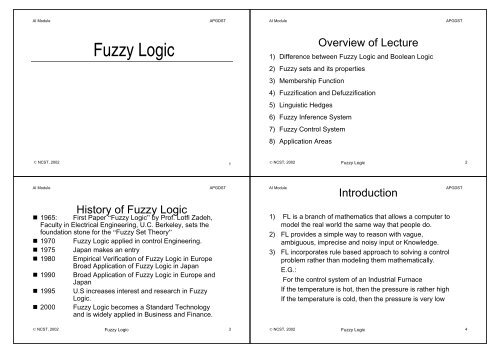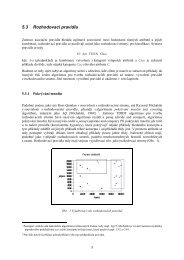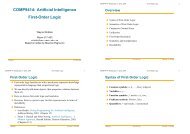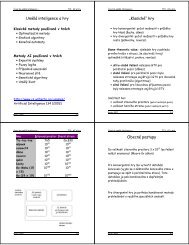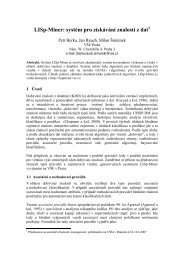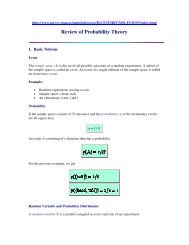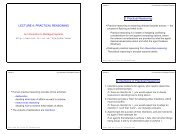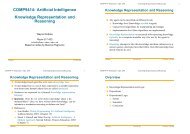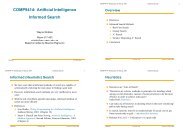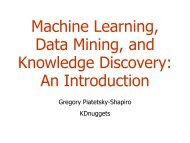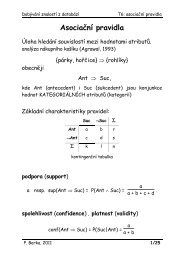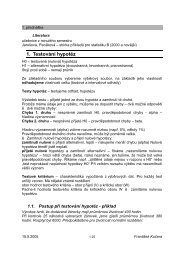Fuzzy Logic - Sorry
Fuzzy Logic - Sorry
Fuzzy Logic - Sorry
You also want an ePaper? Increase the reach of your titles
YUMPU automatically turns print PDFs into web optimized ePapers that Google loves.
AI Module<br />
APGDST<br />
AI Module<br />
APGDST<br />
<strong>Fuzzy</strong> <strong>Logic</strong><br />
Overview of Lecture<br />
1) Difference between <strong>Fuzzy</strong> <strong>Logic</strong> and Boolean <strong>Logic</strong><br />
2) <strong>Fuzzy</strong> sets and its properties<br />
3) Membership Function<br />
4) Fuzzification and Defuzzification<br />
5) Linguistic Hedges<br />
6) <strong>Fuzzy</strong> Inference System<br />
7) <strong>Fuzzy</strong> Control System<br />
8) Application Areas<br />
© NCST, 2002<br />
1<br />
© NCST, 2002 <strong>Fuzzy</strong> <strong>Logic</strong><br />
2<br />
AI Module<br />
History of <strong>Fuzzy</strong> <strong>Logic</strong><br />
n 1965: First Paper “<strong>Fuzzy</strong> <strong>Logic</strong>” by Prof. Lotfi Zadeh,<br />
Faculty in Electrical Engineering, U.C. Berkeley, sets the<br />
foundation stone for the “<strong>Fuzzy</strong> Set Theory”<br />
n 1970 <strong>Fuzzy</strong> <strong>Logic</strong> applied in control Engineering.<br />
n 1975 Japan makes an entry<br />
n 1980 Empirical Verification of <strong>Fuzzy</strong> <strong>Logic</strong> in Europe<br />
Broad Application of <strong>Fuzzy</strong> <strong>Logic</strong> in Japan<br />
n 1990 Broad Application of <strong>Fuzzy</strong> <strong>Logic</strong> in Europe and<br />
Japan<br />
n 1995 U.S increases interest and research in <strong>Fuzzy</strong><br />
<strong>Logic</strong>.<br />
n 2000 <strong>Fuzzy</strong> <strong>Logic</strong> becomes a Standard Technology<br />
and is widely applied in Business and Finance.<br />
APGDST<br />
AI Module<br />
Introduction<br />
1) FL is a branch of mathematics that allows a computer to<br />
model the real world the same way that people do.<br />
2) FL provides a simple way to reason with vague,<br />
ambiguous, imprecise and noisy input or Knowledge.<br />
3) FL incorporates rule based approach to solving a control<br />
problem rather than modeling them mathematically.<br />
E.G.:<br />
For the control system of an Industrial Furnace<br />
If the temperature is hot, then the pressure is rather high<br />
If the temperature is cold, then the pressure is very low<br />
APGDST<br />
© NCST, 2002 <strong>Fuzzy</strong> <strong>Logic</strong><br />
3<br />
© NCST, 2002 <strong>Fuzzy</strong> <strong>Logic</strong><br />
4
AI Module<br />
<strong>Fuzzy</strong> & Boolean<br />
<strong>Logic</strong><br />
APGDST<br />
AI Module<br />
<strong>Fuzzy</strong> & Boolean <strong>Logic</strong><br />
APGDST<br />
1) In Boolean <strong>Logic</strong> every statement is true or false ie.. it has a<br />
truth value 1 or 0. Boolean sets impose rigid membership<br />
requirements.<br />
2) In contrast, fuzzy sets have more flexible membership<br />
requirements that allow for partial membership in a set.<br />
3) Everything is a matter of degree and exact reasoning is<br />
viewed as a limiting case of approximate reasoning. Hence<br />
we can conclude that Boolean <strong>Logic</strong> is a subset of <strong>Fuzzy</strong><br />
<strong>Logic</strong>.<br />
Traditional Sets<br />
The fig indicates that a person securing 80%<br />
marks belongs to the set of Intelligent<br />
students with a degree of membership of 0.5<br />
© NCST, 2002 <strong>Fuzzy</strong> <strong>Logic</strong><br />
5<br />
© NCST, 2002 <strong>Fuzzy</strong> <strong>Logic</strong><br />
6<br />
AI Module<br />
29°C<br />
Conventional (Boolean) Set Theory:<br />
25°C<br />
50°C<br />
30°C<br />
42°C<br />
<strong>Fuzzy</strong> & Boolean <strong>Logic</strong><br />
35°C<br />
“Hot Weather”<br />
30°C<br />
Weather can only be classified as warm<br />
or cold. 29°C and 30°C fall are included<br />
in cold weather although they fall in the<br />
category of warm weather.<br />
The boundary between hot and cold<br />
weather is fuzzy. Temperatures like<br />
29°C and 30°C fall into that fuzzy<br />
region which is light grey.<br />
30°C<br />
25.2°C<br />
<strong>Fuzzy</strong> Set Theory:<br />
32.7°C<br />
50°C<br />
42°C 29°C<br />
“Hot Weather”<br />
APGDST<br />
© NCST, 2002 <strong>Fuzzy</strong> <strong>Logic</strong><br />
7<br />
AI Module<br />
{( x,<br />
µ ( x))<br />
x∈U}<br />
A= |<br />
<strong>Fuzzy</strong> sets<br />
Definition : A fuzzy set A on a universe U is characterized by a<br />
membership function (x) that takes the values in the<br />
interval[0,1].<br />
APGDST<br />
A fuzzy set A in U may be represented as a set of ordered pairs.<br />
Each pair consists of a generic element x and its grade of membership. It<br />
is given by<br />
T ( x)<br />
= {<br />
T<br />
1<br />
x<br />
,<br />
T<br />
1<br />
x<br />
,.......<br />
µ ( x ) = {<br />
1<br />
µ<br />
x<br />
2<br />
µ<br />
,.......<br />
© NCST, 2002 <strong>Fuzzy</strong> <strong>Logic</strong><br />
8<br />
T<br />
k<br />
x<br />
}<br />
,<br />
x<br />
i<br />
µ<br />
Term Sets : Term set contains fuzzy numbers. The term set for<br />
representing heights of people is T(X)= {Tall, Medium, Short}<br />
x<br />
}
AI Module<br />
APGDST<br />
AI Module<br />
APGDST<br />
<strong>Fuzzy</strong> Sets<br />
1<br />
<strong>Fuzzy</strong> set properties<br />
1<br />
µ<br />
Let A be a fuzzy interval between 2 and 4 B be a fuzzy number about 1<br />
1<br />
This figure shows the fuzzy set<br />
between 2 and 4 AND about 1<br />
© NCST, 2002 <strong>Fuzzy</strong> <strong>Logic</strong><br />
9<br />
© NCST, 2002 <strong>Fuzzy</strong> <strong>Logic</strong><br />
10<br />
AI Module<br />
APGDST<br />
AI Module<br />
APGDST<br />
<strong>Fuzzy</strong> set properties…<br />
1<br />
The <strong>Fuzzy</strong> set between 2 and 4 OR about 1(again, it is the<br />
pink line).<br />
1<br />
The blue line is the NEGATION of the fuzzy set A<br />
© NCST, 2002 <strong>Fuzzy</strong> <strong>Logic</strong><br />
11<br />
© NCST, 2002 <strong>Fuzzy</strong> <strong>Logic</strong><br />
12
AI Module<br />
Membership Function<br />
Membership function Maps elements of <strong>Fuzzy</strong> set<br />
to real numbered value in the interval 0 to 1<br />
For Core elements (x) =1<br />
For Support elements (x) > 0<br />
For Boundary elements (x) > 0<br />
but (x) ! =1<br />
Based on membership functions the fuzzy sets are classified<br />
into two types<br />
1) Normal <strong>Fuzzy</strong> set<br />
A set is one whose membership function has at least<br />
one element whose degree of membership is equal to<br />
one.<br />
APGDST<br />
© NCST, 2002 <strong>Fuzzy</strong> <strong>Logic</strong><br />
13<br />
AI Module<br />
2) Convex <strong>Fuzzy</strong> set<br />
Co<br />
Membership Function<br />
APGDST<br />
A Convex <strong>Fuzzy</strong> set is described by the membership function whose<br />
membership values are strictly monotonically increasing or whose<br />
membership values are strictly monotonically decreasing or whose<br />
membership values are strictly monotonically increasing and then strictly<br />
monotonically decreasing for increasing values of elements in the<br />
universe.<br />
Mathematical Expression:<br />
For any element x,y zin fuzzy set A,<br />
the relation x
AI Module<br />
Defuzzification<br />
APGDST<br />
It converts the fuzzy value into a "crisp" value. This<br />
process is often complex since the resulting fuzzy set might<br />
not translate directly into a crisp value. Physical systems<br />
need discrete values and hence Defuzzification is important.<br />
The different methods of Defuzzification are<br />
1) Max-Membership Principle: This method chooses the<br />
element with the maximum value.<br />
µ ( z<br />
* ) ≥ ( z)<br />
c<br />
µ<br />
c<br />
AI Module<br />
z<br />
*<br />
=<br />
∑<br />
∑<br />
z<br />
c<br />
*<br />
=<br />
µ ( z)<br />
c<br />
Defuzzification<br />
∫<br />
∫<br />
µ ( z).<br />
zdz<br />
c<br />
µ ( z)<br />
dz<br />
c<br />
APGDST<br />
2) Centroid Method: The centroid defuzzification method finds the “balance”<br />
point of the solution fuzzy region by calculating the weighted mean of the output<br />
fuzzy region.<br />
3) Weighted Average Method: The weighted average method is formed by<br />
weighting each membership function in the output by its respective maximum<br />
membership value.<br />
µ ( z)<br />
z<br />
z<br />
*<br />
a(0.5)<br />
=<br />
0.5<br />
+<br />
+<br />
b(0.9)<br />
0.9<br />
© NCST, 2002 <strong>Fuzzy</strong> <strong>Logic</strong><br />
17<br />
© NCST, 2002 <strong>Fuzzy</strong> <strong>Logic</strong><br />
18<br />
AI Module<br />
Linguistic Hedges<br />
APGDST<br />
n Hedges are modifiers of fuzzy values and allow generation of<br />
fuzzy statements through mathematical calculations.<br />
n Hedges act on fuzzy set’s membership function to modify it.<br />
Hedges play the same role in <strong>Fuzzy</strong> production rules that<br />
adjectives and adverbs play in English sentences.<br />
AI Module<br />
Concentrator hedge intensifies the<br />
fuzzy region.<br />
n<br />
µ ( x)<br />
= µ ( x)<br />
con ( A)<br />
A<br />
where n>=1.<br />
Linguistic Hedges<br />
APGDST<br />
n Depending on their impact on the membership function, the<br />
hedges are classified as concentrators, dilators and contrast<br />
hedges.<br />
Dilator hedge which dilutes the<br />
force of fuzzy set membership<br />
function. .<br />
1 /<br />
µ ( x)<br />
= µ<br />
dil ( A )<br />
A<br />
n<br />
( x)<br />
In the fig. “very warm” represents the concentrator<br />
And “rather warm” represents dilator<br />
© NCST, 2002 <strong>Fuzzy</strong> <strong>Logic</strong><br />
19<br />
© NCST, 2002 <strong>Fuzzy</strong> <strong>Logic</strong><br />
20
AI Module<br />
Linguistic Hedges<br />
APGDST<br />
AI Module<br />
<strong>Fuzzy</strong> inference system<br />
APGDST<br />
The contrast hedges change the<br />
nature of the fuzzy region by<br />
making it either less<br />
fuzzy(intensification) or more<br />
fuzzy(diffusion).<br />
If µ is >= 0.5<br />
1<br />
µ A)<br />
= (<br />
2<br />
1<br />
(<br />
2<br />
µ A<br />
( A))<br />
1<br />
µ A)<br />
= 1−<br />
(<br />
2<br />
1<br />
(<br />
2<br />
µ A<br />
( A))<br />
A fuzzy inference system<br />
essentially defines a nonlinear<br />
mapping of the input data vector<br />
into a scalar output using fuzzy<br />
rules.<br />
else if µ< 0.5<br />
1<br />
µ A)<br />
= 1−<br />
(<br />
2<br />
1<br />
(<br />
2<br />
µ A<br />
( A))<br />
© NCST, 2002 <strong>Fuzzy</strong> <strong>Logic</strong><br />
21<br />
© NCST, 2002 <strong>Fuzzy</strong> <strong>Logic</strong><br />
22<br />
AI Module<br />
Consider a multiinput and multioutput system. Let the input and<br />
output vectors be represented as follows:<br />
x =<br />
T<br />
x<br />
<strong>Fuzzy</strong> inference system<br />
T<br />
x , x , x , x , x ) T<br />
1 2 3 4<br />
( 5<br />
y = ( y , y , y , y , y ) T<br />
x<br />
1<br />
2<br />
T<br />
k<br />
x<br />
3<br />
T<br />
1 1<br />
T ( x)<br />
= { , ,....... }<br />
µ ( x ) = { , ,....... }<br />
i<br />
x<br />
4<br />
The linguistic variable x in the universe of discourse is characterized by<br />
5<br />
1 2<br />
µ µ<br />
x<br />
x<br />
i<br />
µ<br />
x<br />
APGDST<br />
AI Module<br />
. The inputs are<br />
<strong>Fuzzy</strong> inference system<br />
x1=years of education<br />
x2= years of experience<br />
The output is<br />
y=salary.<br />
Let T(x1) = {low,medium,high} for U in range [0-15].<br />
T(x2 )= { low,medium,high} for U in range [0-30].<br />
Let T(y) = {very low, low, medium, high, very high}<br />
for U in range [ 2000, 20000].<br />
APGDST<br />
© NCST, 2002 <strong>Fuzzy</strong> <strong>Logic</strong><br />
23<br />
© NCST, 2002 <strong>Fuzzy</strong> <strong>Logic</strong><br />
24
AI Module<br />
Step 2<br />
<strong>Fuzzy</strong> inference system<br />
Fuzzification of the input<br />
APGDST<br />
AI Module<br />
<strong>Fuzzy</strong> inference system<br />
APGDST<br />
A fuzzy rule base contains a set of fuzzy rules R. An example of the<br />
rule can be<br />
“If education is high and experience is high, then the salary is very<br />
high”<br />
In general for a multiinput and multioutput system, R = , ,......, )<br />
( R1 R2<br />
RN<br />
Membership Function Membership function Membership Function<br />
For X1 for X2 for X3<br />
© NCST, 2002 <strong>Fuzzy</strong> <strong>Logic</strong><br />
25<br />
Copyright NCST, 2002<br />
slide no:24<br />
The i th<br />
R<br />
( y<br />
fuzzy rule is given by<br />
i<br />
=<br />
1<br />
in<br />
If (<br />
T<br />
x<br />
and ....,<br />
x 1<br />
y<br />
in , and .......<br />
1<br />
1<br />
is<br />
T<br />
y<br />
q<br />
© NCST, 2002 <strong>Fuzzy</strong> <strong>Logic</strong><br />
26<br />
x<br />
in<br />
p<br />
is<br />
T<br />
T<br />
y<br />
)<br />
q<br />
) then<br />
x p<br />
T T<br />
1<br />
The p precondition of R form a fuzzy set ( ×<br />
x<br />
× ..... ×<br />
x2<br />
)<br />
x p<br />
And the consequent is given by the union of q independent outputs<br />
T<br />
∪ .....<br />
1 T ∪ ∪<br />
y T<br />
(<br />
y 2<br />
yp<br />
)<br />
T<br />
AI Module<br />
<strong>Fuzzy</strong> inference system<br />
APGDST<br />
Interpreting an if-then rule is a three part process:<br />
a) Resolve all fuzzy statements in the antecedent to a degree of membership<br />
between 0 and 1.<br />
b) If there are multiple parts to the antecedent, apply fuzzy logic operators and<br />
resolve the antecedent to a single number between 0 and 1<br />
c) Apply the implication method, using the degree of support for the entire rule<br />
to shape the output fuzzy set. For eg: consider an ith rule<br />
Ri<br />
Y<br />
: if<br />
is<br />
x1<br />
i<br />
T y<br />
is<br />
T<br />
and<br />
x1<br />
x<br />
2<br />
is<br />
T<br />
then<br />
x2<br />
AI Module<br />
<strong>Fuzzy</strong> inference system<br />
Aggregation: Combining of two or more output fuzzy sets into a<br />
single composite output fuzzy set<br />
APGDST<br />
Then the firing strength or membership of the rule can be defined as<br />
αi<br />
OR<br />
i<br />
= min( µ , µ ,..., µ )<br />
x1<br />
x1<br />
α = ( µ * µ<br />
x2<br />
*.... µ )<br />
1 2<br />
µ ( w)<br />
= max( µ ( w)<br />
µ ( w))<br />
y y y<br />
The result is the defuzzified to obtain a crisp value.<br />
x2<br />
xn<br />
xn<br />
© NCST, 2002 <strong>Fuzzy</strong> <strong>Logic</strong><br />
27<br />
© NCST, 2002 <strong>Fuzzy</strong> <strong>Logic</strong><br />
28
AI Module<br />
<strong>Fuzzy</strong> inference system<br />
APGDST<br />
Eg: Consider the following values as input to the <strong>Fuzzy</strong> Inference System<br />
Education(x1) = 15 years<br />
Experience(x1) = 25 years<br />
To find the output Salary(Y)<br />
Fuzzification of Input: 15 years belongs to the fuzzy set high education with a<br />
membership of 1 and it doesn’t belong to low education or medium education.<br />
25 years belongs to fuzzy set high experience with a membership of 1 and<br />
doesn’t belong to low experience or medium experience.<br />
The firing strength of the rules that get fired is given by<br />
If education is high and experience is low, then the salary is medium<br />
min(1 , 0) = 0<br />
If education is high and experience is medium, then the salary is high<br />
min(1, 0) = 0<br />
© NCST, 2002 <strong>Fuzzy</strong> <strong>Logic</strong><br />
29<br />
AI Module<br />
<strong>Fuzzy</strong> inference system<br />
APGDST<br />
If education is high and experience is high, then the salary is very high.<br />
min(1,1) = 1<br />
If education is low and experience is high, then the salary is medium<br />
min(0,1)=0<br />
If education is medium and experience is high, then the salary is high<br />
min(0, 1) = 0<br />
The output is calculated as<br />
max(0,0,1,0,0) = 1<br />
Hence the salary is high. The degree of membership is 1 which corresponds to<br />
the crisp value of Rs 200,000.<br />
‘<br />
© NCST, 2002 <strong>Fuzzy</strong> <strong>Logic</strong><br />
30<br />
AI Module<br />
APGDST<br />
AI Module<br />
APGDST<br />
<strong>Fuzzy</strong> inference system<br />
Advantage of <strong>Fuzzy</strong> Control Systems over conventional controllers.<br />
<strong>Fuzzy</strong> inference system<br />
Consider the design of a fuzzy controller for a steam turbine<br />
Step 1<br />
The steps to be carried out in any <strong>Fuzzy</strong> Control System are :-<br />
1) The inputs are temperature and Pressure and the output is the<br />
state of Throttle (to decrease the flow of ( steam or fuel to an<br />
engine) by a valve)<br />
1) Identify the inputs and the outputs<br />
2) The term set for Temperautre is { cold, cool, nominal, warm, hot }<br />
2) Create a fuzzy membership function for each<br />
The term set for Pressure is { weak, low, ok, strong, high}<br />
3) Construct the Rule base<br />
4) Decide how the action will be carried out.<br />
© NCST, 2002 <strong>Fuzzy</strong> <strong>Logic</strong><br />
31<br />
© NCST, 2002 <strong>Fuzzy</strong> <strong>Logic</strong><br />
32
AI Module<br />
<strong>Fuzzy</strong> inference system<br />
APGDST<br />
Membership Functions for Temperature<br />
Membership Functions for Pressure<br />
1/DUJHQHJDWLYH<br />
10HGLXPQHJDWLYH<br />
16PDOOQHJDWLYH<br />
==HUR<br />
36PDOOSRVLWLYH<br />
30HGLXPSRVLWLYH<br />
3/DUJHSRVLWLYH<br />
© NCST, 2002 <strong>Fuzzy</strong> <strong>Logic</strong><br />
33<br />
AI Module<br />
<strong>Fuzzy</strong> inference system<br />
APGDST<br />
Step 3: Construct the Rule base.<br />
UXOH,)WHPSHUDWXUH,6FRRO$1'SUHVVXUH,6ZHDN7+(1WKURWWOHLV3<br />
UXOH,)WHPSHUDWXUH,6FRRO$1'SUHVVXUH,6ORZ7+(1WKURWWOHLV3<br />
UXOH,)WHPSHUDWXUH,6FRRO$1'SUHVVXUH,6RN7+(1WKURWWOH LV=<br />
UXOH,)WHPSHUDWXUH,6FRRO$1'SUHVVXUH,6VWURQJ7+(1WKURWWOHLV<br />
1<br />
(J&RQVLGHUWKDWWKHSUHVVXUHLVLQORZVHWZLWKDPHPEHUVKLS<br />
RI DQGLQ RNVWDWHZLWKDPHPEHUVKLSRI7KHWHPSHUDWXUHLV<br />
DVVXPHGWREHLQFRRO VWDWHZLWKPHPEHUVKLSRI7KH<br />
UXOHVZKLFK ILUHDUH5XOHDQG5XOH<br />
7KHRXWSXWRI5XOH <br />
7KHRXWSXWRI5XOH <br />
© NCST, 2002 <strong>Fuzzy</strong> <strong>Logic</strong><br />
34<br />
AI Module<br />
<strong>Fuzzy</strong> inference system<br />
6WHS 'HFLGLQJRQWKHDFWLRQ$OOWKHUXOHVIRUZKLFKWKH<br />
DQWHFHGHQWVKDYHPHPEHUVKLSYDOXHVJUHDWHUWKDQ]HURJHW<br />
ILUHGThe Rule2 fires to a greater strength and hence it gets<br />
selected for deciding the output state. The value is defuzzified and<br />
the throttle is left as it is.<br />
APGDST<br />
© NCST, 2002 <strong>Fuzzy</strong> <strong>Logic</strong><br />
35<br />
AI Module<br />
Advantages of <strong>Fuzzy</strong> <strong>Logic</strong><br />
• Linguistic, not numerical, variables are used, making it<br />
similar to the way humans think.<br />
• Simplicity allows the solution of previously unsolved<br />
problems because they do away with complex analytical<br />
equations used to model traditional control systems<br />
• Rapid prototyping is possible because a system designer<br />
doesn’t have to know everything about the system before<br />
starting work.<br />
• They’re cheaper to make than conventional systems<br />
because they’re easier to design.<br />
• They have increased robustness.<br />
APGDST<br />
© NCST, 2002 <strong>Fuzzy</strong> <strong>Logic</strong><br />
36
AI Module<br />
APGDST<br />
Application Areas<br />
<strong>Fuzzy</strong> Rule Based Systems<br />
<strong>Fuzzy</strong> Nonlinear Simulations<br />
<strong>Fuzzy</strong> Decision Making<br />
<strong>Fuzzy</strong> Classification<br />
<strong>Fuzzy</strong> Pattern Recognition<br />
<strong>Fuzzy</strong> Control Systems<br />
© NCST, 2002 <strong>Fuzzy</strong> <strong>Logic</strong><br />
37


